
permaculture basics
about me
permaculture links
Creating space:
Many people think of a food producing garden as being a flat area planted in annual veges. This does not have to be the case. A key concept in permaculture is the planting of perennials so that food is easily available with a minimum of work. Permaculture gardens which have been untended for many years still bear prolifically. To our eyes they may be untidy, but from Nature's viewpoint, they are just perfect. So the aim is to develop your garden into a food forest by using and creating as much vertical space as possible. Examples of the use of vertical space include:
• Training vines, e.g. grapes, passionfruit and berry fruit, along wires or netting attached to fences, retaining walls and, in our garden, a shipping container.
• Espaliering fruit trees along fences (if the trees are compatible varieties, graft the branches into each other to form a living trellis).
• Growing climbing beans and tall-growing peas along fences.
• Training climbing plants around the balustrades of raised decks or over the walls of your house or other buildings.
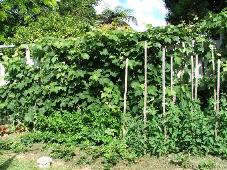
Fig. 1: Grapes growing on a fence behind tomatoes and parsnips with strawberries at the edge of the garden.

Fig. 2: Passionfruit trained to cover the railings of a second storey deck.
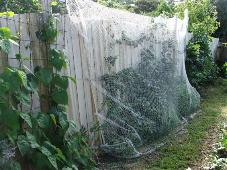
Fig. 3: A productive fenceline with climbing beans in the foreground climbing on steel reinforcing mesh, with netting-covered boysenberries behind, then a young expaliered fig tree, with young loganberries, raspberries and thornless blackberries behind that.
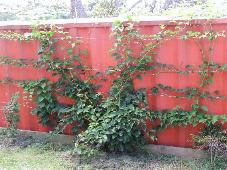
Fig. 4: A young cocktail kiwifruit growing up the side of a shipping container used for extra storage. The container attracts and stores heat allowing for faster growth and more rapid fruit ripening.
Plants climbing on walls of a house provide insulation against temperature extremes, keeping the living areas cooler in summer and warmer in winter. At the same time, the house moderates the climate for the plants, maintaining a warmer environment in winter and preventing frost damage to frost-sensitive plants. If you need to maintain the wall, e.g. for painting, you can construct a hinged frame which can be tilted away from the wall for maintenance without damage to the plants.
Where climbing plants are grown on netting or wires, lower growing plants can be grown beneath them. Examples in my own garden include currant bushes growing beneath a passionfruit vine, which climbs to an upper level deck balustrade, herbs growing beneath a grape vine and boysenberries, and lettuces, herbs and dwarf peas growing beneath a grape vine. This placement benefits all the plants, the low plants providing ground cover to conserve soil moisture while the vines provide protection from the harsh, overhead summer sun, yet allow adequate sunlight once the sun is at a lower angle. The use of dwarf peas and beans is particularly beneficial because these legumes fix nitrogen from the air into the soil and this is available as nitrogenous fertiliser for adjacent plants.
Some useful plants:
Permaculture seeks to provide food in a sustainable manner, but some particularly useful plants are not grown primarily for food. The basic principle when considering the suitability of plant species is that every plant should provide at least 3 benefits (this principle applies to all elements in the permaculture design including plants, animals and structures). These benefits may be for humans directly, for other animals (including insects), or for other plants (e.g. shade and water conservation as described above). Plants which are beneficial in a large installation may not be desirable on a small site, e.g. gorse is useful when establishing forestry but would be undesirable on a 1000sqm section
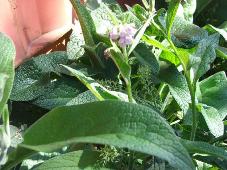 1. Comfrey (Symphytum officinale): This deep-rooted perennial is very suitable for garden edges or for growing under climbing plants (as
described above). Being deep-rooted it does not compete with shallow rooted plants. It gathers nutrients from several metres down in the soil,
concentrates these in its leaves, and adds these minerals to the soil surface when the leaves die. The coarsely hairy leaves may be made into a
compost `tea' by adding them to a drum of water and allowing them to decompose for a few weeks, then using the liquid fertiliser, while the sludge
goes into the compost bin. If you do not wish to make liquid fertiliser, you can compost the leaves directly. It is easily propagated by root
cutting, does not spread and the highly nutritious leaves are useful for feeding animals, e.g. chickens. Comfrey is also said to stop the spread
of kikuyu grass when planted along the edge of a garden. It is a useful herbal remedy as a poultice or ointment for the external treatment of
cuts, abrasions, bruises, sprains and fractures. Consult a herbalist for more information. Be aware that the deep-rooting nature of comfrey
makes it almost impossible to eradicate, and that comfrey has a similar leaf to the poisonous foxglove (Digitalis) so positive identification
is essential.
1. Comfrey (Symphytum officinale): This deep-rooted perennial is very suitable for garden edges or for growing under climbing plants (as
described above). Being deep-rooted it does not compete with shallow rooted plants. It gathers nutrients from several metres down in the soil,
concentrates these in its leaves, and adds these minerals to the soil surface when the leaves die. The coarsely hairy leaves may be made into a
compost `tea' by adding them to a drum of water and allowing them to decompose for a few weeks, then using the liquid fertiliser, while the sludge
goes into the compost bin. If you do not wish to make liquid fertiliser, you can compost the leaves directly. It is easily propagated by root
cutting, does not spread and the highly nutritious leaves are useful for feeding animals, e.g. chickens. Comfrey is also said to stop the spread
of kikuyu grass when planted along the edge of a garden. It is a useful herbal remedy as a poultice or ointment for the external treatment of
cuts, abrasions, bruises, sprains and fractures. Consult a herbalist for more information. Be aware that the deep-rooting nature of comfrey
makes it almost impossible to eradicate, and that comfrey has a similar leaf to the poisonous foxglove (Digitalis) so positive identification
is essential. 2. Marigold and calendula: These plants have been grown as flowering plants for many years but have an important place in the vegetable garden
as the strong-scented flowers confuse the olfactory direction finding sensors of white butterflies, making it more difficult for them to find
brassica plants (cabbage, cauliflower, broccoli), thereby reducing the number of caterpillars on these plants. As both marigold and calendula
plants self seed easily, they can virtually be ignored in the garden and will self-propagate throughout the year. However, being small, low-growing
plants, they do not compete aggressively with food plants for space in the garden and will act as a ground cover wherever they are growing until
you wish to plant another plant in that space.
2. Marigold and calendula: These plants have been grown as flowering plants for many years but have an important place in the vegetable garden
as the strong-scented flowers confuse the olfactory direction finding sensors of white butterflies, making it more difficult for them to find
brassica plants (cabbage, cauliflower, broccoli), thereby reducing the number of caterpillars on these plants. As both marigold and calendula
plants self seed easily, they can virtually be ignored in the garden and will self-propagate throughout the year. However, being small, low-growing
plants, they do not compete aggressively with food plants for space in the garden and will act as a ground cover wherever they are growing until
you wish to plant another plant in that space.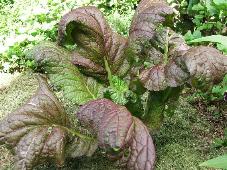 3. Mustard: While the leaves of the mustard can be eaten (steamed or in salads), it is generally not grown primarily as a food plant. Mustard
plants attract aphids, and when they are flowering the flower stems can be covered in feeding aphids, which do no visible harm to the plant and
serve to attract them away from more susceptible plants. Close examination of these aphids usually reveals that they have been parasitised by a
small ichneumenoid wasp, which itself eats many herbivorous insects. These aphids are therefore living incubators which will die when the young
wasps hatch. The seed heads of the mustard plant are generally covered with these dead aphid bodies, as well as containing copious quantities of
mustard seed which provide the next generation. Mustard can grow quite large so it may be necessary to remove most of the plants and leave only
a few to produce seed.
3. Mustard: While the leaves of the mustard can be eaten (steamed or in salads), it is generally not grown primarily as a food plant. Mustard
plants attract aphids, and when they are flowering the flower stems can be covered in feeding aphids, which do no visible harm to the plant and
serve to attract them away from more susceptible plants. Close examination of these aphids usually reveals that they have been parasitised by a
small ichneumenoid wasp, which itself eats many herbivorous insects. These aphids are therefore living incubators which will die when the young
wasps hatch. The seed heads of the mustard plant are generally covered with these dead aphid bodies, as well as containing copious quantities of
mustard seed which provide the next generation. Mustard can grow quite large so it may be necessary to remove most of the plants and leave only
a few to produce seed. 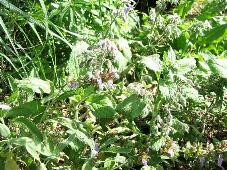 4. Borage (Borago officinalis): Blue borage flowers make colourful additions to salads or can be floated on cool summer drinks. However,
from a permacultural viewpoint, borage is excellent bee fodder, attracting bees and assisting in the pollination of other plants whose flowers
may lack food value for bees (e.g. kiwifruit, tomatoes). Borage self-seeds prolifically and if left for too long can grow straggly and sprawl
over a large area.
4. Borage (Borago officinalis): Blue borage flowers make colourful additions to salads or can be floated on cool summer drinks. However,
from a permacultural viewpoint, borage is excellent bee fodder, attracting bees and assisting in the pollination of other plants whose flowers
may lack food value for bees (e.g. kiwifruit, tomatoes). Borage self-seeds prolifically and if left for too long can grow straggly and sprawl
over a large area. Custom permaculture designs to suit your needs
Alan Willoughby MSc, PDC * PO Box 296, Tauranga, New Zealand * Tel (07) 544 3087 * willoughbys@xtra.co.nz
© 2006-9 Permaculture Designz
Site designed by Dreamscape